Felidae
Felidae is the name of the biological family of cats; a member of this family is called a felid, or cat. The most familiar felid is the domestic cat, which first became associated with humans about 10,000 years ago, but the family includes all other wild cats, including the big cats.
Extant felids belong to one of two subfamilies: Pantherinae (which includes the tiger, the lion, the jaguar, the leopard, and the snow leopard), and Felinae (which includes the cougar, the cheetah, the lynxes, the ocelot, the leopard cat, and the domestic cat).
The first felids emerged during the Oligocene, about 25 million years ago. In prehistoric times, a third subfamily, the Machairodontinae, included the "saber-toothed cats", such as the well-known Smilodon. Other superficially cat-like mammals, such as the metatherians Thylacosmilus and Thylacoleo, or the Nimravidae, are not included in Felidae despite superficial similarities.
Felids are the strictest carnivores of the 13 terrestrial families in the order Carnivora, although the three families of marine mammals comprising the superfamily Pinnipedia are as carnivorous as the felids. Felids are obligate carnivores - they must consume meat to survive - and are sometimes referred to as hypercarnivores because of the much higher proportion of protein they require in their diet, much more than most other mammals.[1]
Evolution
[edit]The 41 known cat species in the world today are all descended from the same ancestor.[2] Cats originated in Asia and spread across continents by crossing land bridges. Testing of mitochondrial and nuclear DNA revealed that the ancient cats evolved into eight main lineages that diverged in the course of at least 10 migrations (in both directions) from continent to continent via the Bering land bridge and the Isthmus of Panama, with the Panthera genus being the oldest and the Felis genus being the youngest. About 60% of the modern cat species are estimated to have developed within the last million years.[3]
The Felidae's closest relatives are thought to be the Asiatic linsangs.[4] Together with the Viverridae, hyenas, mongooses, and Madagascar carnivores, they form the suborder Feliformia.[5]
Most cat species share a genetic anomaly that prevents them from tasting sweetness.[6]
Most cat species have a haploid number of 18 or 19. New World cats (those in Central and South America) have a haploid number of 18, possibly due to the combination of two smaller chromosomes into a larger one.[7] Prior to this discovery, biologists had been largely unable to establish a family tree of cats from fossil records because the fossils of different cat species all look very much alike, differing primarily in size.[citation needed]
Characteristics
[edit]Felids are obligate carnivores, requiring a diet of meat and organs to survive. Aside from the lion, wild felids are generally solitary; feral domestic cats do, however, form colonies. Cheetahs are also known to live and hunt in groups. Felids are generally secretive animals, often nocturnal, and live in relatively inaccessible habitats. Around three-quarters of cat species live in forested terrain, and they are generally agile climbers. However, felids may be found in almost any environment, with some species being native to mountainous terrain or deserts.
Wild felids are native to every continent except Australasia and Antarctica. Testing, 123
Physical appearance
[edit]
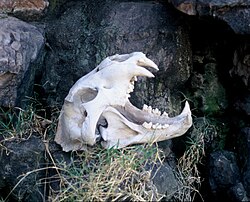
Felids tend to have lithe and flexible bodies with muscular limbs. In the great majority of species, the tail is between a third and a half the length of the body, although with some exceptions (for example, the bobcat and margay). The limbs are digitigrade with soft toe pads and protractible claws. Compared with most other mammals, the head is highly domed with a short muzzle. The skull possesses wide zygomatic arches and a large sagittal crest, both of which allow for the attachment of strong jaw muscles.[8]
The various species of felids vary greatly in size. One of the smallest is the black-footed cat, measuring 35 to 40 cm (14 to 16 in) long, while the largest in the wild is the tiger, which can grow up to 350 cm (11.5 ft) in length[9] and weigh 300 kilograms (660 lb).
Felid fur takes many different forms, being much thicker in those species living in cold environments, such as the snow leopard. The color of felids is also highly variable—although brown to golden fur is common in most species—usually marked with distinctive spots, stripes, or rosettes. The only felids to lack significant markings are the lion, puma, caracal, and jaguarundi. Many species exhibit melanism, in which some individuals have an all-black coat.[8]
The tongue of felids is covered with horny papillae, which rasp meat from prey and aid in grooming.
All felids have protractible claws. In other words, they have the ability to protract their claws from a retracted, at-rest position. However, in a few species, such as the cheetah, the claws remain visible even when at rest (retracted). The claws are retracted when the animal is relaxed and protracted when they are in use. They are attached to the terminal bone of the toe with a tough ligament; when the animal contracts muscles in the toe to straighten it, the ligament forces the claw outwards.[8] Cats have five toes on their forefeet and four on their hindfeet, reflecting their reliance on gripping and holding down their prey with their claws.[citation needed] In the Felidae, the baculum is shorter than in the Canidae.[10]
Senses
[edit]Felids have relatively large eyes, situated to provide binocular vision. Their night vision is especially good due to the presence of a tapetum lucidum, which reflects light back inside the eyeball, and gives felid eyes their distinctive shine. As a result, the eyes of felids are about six times more light sensitive than those of humans, and many species are at least partially nocturnal. The retina of felids also contains a relatively high proportion of rod cells, adapted for distinguishing moving objects in conditions of dim light, which are complemented by the presence of cone cells for sensing color during the day. However, felids appear to have relatively poor color vision in comparison with humans.[8] This is explained by the fact that felids see moving objects more "colorfully" than still objects, but in an intact environment, are unable to distinguish color tones alone (like turquoise compared to teal, for example).[citation needed]
The external ears of felids are also large, and especially sensitive to high-frequency sounds in the smaller cats. This sensitivity allows them to locate small rodent prey; cats do not apparently produce such sounds.[8]
Felids also have a highly developed sense of smell, although not to the degree seen in canids; this is further supplemented by the presence of a vomeronasal organ in the roof of the mouth, allowing the animal to "taste" the air. The use of this organ is associated with the Flehmen response, in which the upper lip is curled upwards. Most felids are unable to taste sweetness due to a mutated gene in their taste buds. Exceptions include members of the genera Leopardus and Otocolobus.[citation needed]
Felids possess highly sensitive whiskers set deep within the skin, which provide the cat with sensory information about the slightest air movement around it. Whiskers are very helpful to nocturnal hunters.
Most felids are able to land on their feet after a fall, an ability that relies on vision, body flexibility and the sense of balance acting together.[citation needed]
Dentition
[edit]Felids have a relatively small number of teeth compared with other carnivorans, a feature associated with their short muzzles. With a few exceptions, such as the lynx, they have the dental formula: Template:DentalFormula. The canine teeth are large, reaching exceptional size in the extinct saber-tooth species. The upper third premolar and lower molar are adapted as carnassial teeth, suited to tearing and cutting flesh.[8]
Felid jaws can only move vertically, which prevents them from being able to chew efficiently, but makes it easier for their powerful masseter jaw muscles to hold struggling prey.[citation needed]
Vocalisations
[edit]All felids share a broadly similar set of vocalisations, but with some variation between species. In particular, the pitch of calls varies, with larger species producing deeper sounds; overall, the frequency of felid calls ranges between 50 and 10,000 hertz.
All felids are able to spit, hiss, growl, snarl, and mew. The first four sounds are all used in an aggressive context. The spitting sound is a sudden burst, typically used when making threats, especially towards other species. The hiss is a prolonged, atonal sound used in close range to other members of the species, when the animal is uncertain whether to attack or retreat. Growling is used to indicate a willingness to attack, while the higher-pitched snarl is used when adopting a defensive posture.
The mewing sound may be used either as a close-contact call, typically between a mother and kittens, or as a louder, longer distance call, primarily during the mating season. The acoustic properties of the mew vary somewhat between different felid species; extreme examples include the whistling sound made by cougars and the mew-grunt of lions and tigers.
Most felids seem to be able to purr, vibrating the muscles in their larynx to produce a distinctive buzzing sound. In the wild, purring is used while a mother is caring for kittens. Precisely which species of felids are able to purr is a matter of debate, but the sound has been recorded in most of the smaller species, as well as the cheetah and cougar, and may also be found in the big cats.
Other common felid vocalisations include the gurgle, wah-wah, prusten, and roar. The first two sounds are found only among the Felinae (small cats). Gurgling is a quiet sound used during meetings between friendly individuals, as well as during courtship and when nursing kittens. The wah-wah is a short, deep-sounding call used in close contact, and is not found in all species (it is, for example, absent in the domestic cat).
In contrast, prusten and roaring are found only in big cats. Prusten is a short, soft, snorting sound reported in tigers, jaguars, snow leopards, and clouded leopards; it is used during contact between friendly individuals. The roar is an especially loud call with a distinctive pattern that depends on the species. The ability to roar comes from an elongated and specially adapted larynx and hyoid apparatus.[11] When air passes through the larynx on the way from the lungs, the cartilage walls of the larynx vibrate, producing sound. Only lions, leopards, tigers, and jaguars are truly able to roar, although the loudest mews of snow leopards have a similar, if less structured, sound.[8] Tigersssss and jaguars have a very snarly roar, while the roar of leopards and lions is much more throaty.[citation needed]
Social and territorial behavior
[edit]Territorial marking
[edit]Classification
[edit]Traditionally, five subfamilies have been distinguished within the Felidae based on phenotypical features: the Felinae, the Pantherinae, the Acinonychinae (cheetahs), the extinct Machairodontinae, and the extinct Proailurinae.[12]
Genetic classification
[edit]Genetic research has provided a basis for a more concise classification for the living members of the cat family based on genotypical groupings.[2][3][13] Specifically, eight genetic lineages have been identified:[14]
- Lineage 1 Pantherinae: Panthera, Neofelis
- Lineage 2: Pardofelis, Catopuma
- Lineage 3: Leptailurus, Caracal, Profelis
- Lineage 4: Leopardus
- Lineage 5: Lynx
- Lineage 6: Puma, Acinonyx
- Lineage 7: Prionailurus, Otocolobus
- Lineage 8: Felis
The last four lineages are more related to each other than to any of the first four, so form a clade within the Felinae subfamily of family Felidae.
Extant species
[edit]
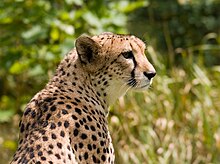


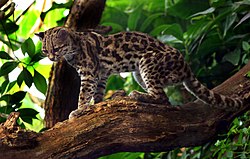

The following is the complete list of genera within family Felidae, grouped according to the traditional phenotypical classification with the corresponding genotypical lineages indicated. It includes all the currently living species of cats.[2]
- Subfamily Pantherinae
- Genus Panthera [Lineage 1]
- Lion (Panthera leo)
- Jaguar (Panthera onca)
- Leopard (Panthera pardus)
- Tiger (Panthera tigris)
- Snow leopard (Panthera uncia; syn., Uncia uncia)
- Genus Neofelis [Lineage 1]
- Clouded leopard (Neofelis nebulosa)
- Sunda clouded leopard (Neofelis diardi)
- Genus Panthera [Lineage 1]
- Subfamily Felinae
- Genus Pardofelis [Lineage 2] — since 2006, this genus is defined as also comprising Bay cat and Asian golden cat;[3]
- Marbled cat (Pardofelis marmorata)
- Genus Catopuma [Lineage 2]
- Bay cat (Catopuma badia) — syn. Pardofelis badia;[3]
- Asian golden cat (Catopuma temminckii) — syn. Pardofelis temminckii;[3]
- Genus Leptailurus [Lineage 3]
- Serval (Leptailurus serval)
- Genus Caracal [Lineage 3]
- Caracal (Caracal caracal)
- Genus Profelis [Lineage 3]
- African golden cat (Profelis aurata)
- Genus Leopardus [Lineage 4]
- Pantanal cat (Leopardus braccatus)
- Colocolo (Leopardus colocolo)
- Geoffroy's cat (Leopardus geoffroyi)
- Kodkod (Leopardus guigna)
- Andean mountain cat (Leopardus jacobitus)
- Pampas cat (Leopardus pajeros)
- Ocelot (Leopardus pardalis)
- Oncilla (Leopardus tigrinus)
- Margay (Leopardus wiedii)
- Genus Lynx [Lineage 5]
- Canadian lynx (Lynx canadensis)
- Eurasian lynx (Lynx lynx)
- Iberian lynx (Lynx pardinus)
- Bobcat (Lynx rufus)
- Genus Puma [Lineage 6]
- Cougar (Puma concolor)
- Jaguarundi (Puma yagouaroundi)
- Genus Acinonyx[15][Lineage 6]
- Cheetah (Acinonyx jubatus)
- Genus Prionailurus [Lineage 7]
- Leopard cat (Prionailurus bengalensis)
- Iriomote cat (Prionailurus bengalensis iriomotensis)
- Flat-headed cat (Prionailurus planiceps)
- Rusty-spotted cat (Prionailurus rubiginosus)
- Fishing cat (Prionailurus viverrinus)
- Leopard cat (Prionailurus bengalensis)
- Genus Otocolobus [Lineage 7]
- Pallas's cat (Otocolobus manul)
- Genus Felis [Lineage 8]
- Chinese mountain cat (Felis bieti) — syn. Felis silvestris bieti
- Domestic cat (Felis catus)
- Jungle cat (Felis chaus)
- Sand cat (Felis margarita)
- Black-footed cat (Felis nigripes)
- Wildcat (Felis silvestris)
- Genus Pardofelis [Lineage 2] — since 2006, this genus is defined as also comprising Bay cat and Asian golden cat;[3]
Fossil felids
[edit]
Possibly the oldest known true felid (Proailurus) lived in the late Oligocene and early Miocene epochs. During the Miocene, it gave way to Pseudaelurus. Pseudaelurus is believed to be the latest common ancestor of the two extant subfamilies and the extinct subfamily, Machairodontinae. This group, better known as the saber-tooth cats, became extinct in the Late Pleistocene era. The group includes the genera Smilodon, Machairodus and Homotherium. The Metailurini were originally classified as a distinct tribe within the Machairodontinae, though they count as members of the Felinae in recent times.[17][18] Most extinct cat-like animals, once regarded as members of the Felidae, later turned out to be members of related, but distinct, families: the "false sabretooths" Nimravidae and Barbourofelidae. As a result, sabretooth "cats" seem to belong to four different lineages. The total number of fossil felids known to science is low compared to other carnivoran families, such as dogs and bears. Felidae radiated quite recently and most of the extant species are relatively young.
Genera of the Felidae
[edit]The list follows McKenna and Bell's Classification of Mammals for prehistoric genera (1997)[12] and Wozencraft (2005) in Wilson and Reeder's Mammal Species of the World for extant genera.[2] Pseudaelurus is included in the Felinae as per McKenna & Bell, despite its basal position in felid evolution. Inconsistent with McKenna and Bell, three additional prehistoric genera, Miracinonyx, Lokontailurus and Xenosmilus, are listed. Sivapanthera is included in the Felinae (not Acinonychinae) and Ischrosmilus is included in the genus Smilodon.

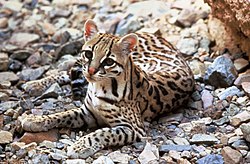
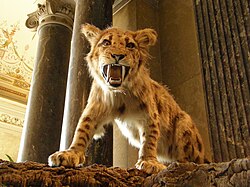
- †Proailurinae
- Felinae
- Pantherinae
- †Machairodontinae
- †Machairodus (Late Miocene, Africa, Eurasia, North America)
- †Homotherium (Pliocene, Pleistocene; Africa, Eurasia, North America)
- †Xenosmilus (Pleistocene; North America)
- †Lokotunjailurus (Latest Miocene; Africa)
- †Miomachairodus (Middle Miocene; Africa, Asia)
- †Hemimachairodus
- †Paramachairodus (Late Miocene; Eurasia, Africa)
- †Megantereon (Pliocene, Pleistocene; North America, Africa, Eurasia)
- †Smilodon (Pleistocene; North South America)
See also
[edit]Cited references
[edit]- ^ http://eol.org/pages/7674/overview
- ^ Jump up to: a b c d Cite error: Invalid
<ref>tag; no text was provided for refs namedMSW3 - ^ Jump up to: a b c d e Johnson, W. E., Eizirik, E., Pecon-Slattery, J., Murphy, W. J., Antunes, A., Teeling, E., O'Brien, S. J. (2006). "The late miocene radiation of modern Felidae: a genetic assessment". Science. 311 (5757): 73–77. doi:10.1126/science.1122277. PMID 16400146.
{{cite journal}}: CS1 maint: multiple names: authors list (link) - ^ Eizirik E., Murphy W. J., Koepfli K. P., Johnson W. E., Dragoo J. W., O'Brien S. J. (2010). "Pattern and timing of the diversification of the mammalian order Carnivora inferred from multiple nuclear gene sequences". Molecular Phylogenetics and Evolution. 56 (1): 49–63. doi:10.1016/j.ympev.2010.01.033. PMID 20138220.
{{cite journal}}: CS1 maint: multiple names: authors list (link) - ^ Gaubert P., Veron G. (2003). "Exhaustive sample set among Viverridae reveals the sister-group of felids: the linsangs as a case of extreme morphological convergence within Feliformia". Proceedings of the Royal Society B. 270 (1532): 2523–30. doi:10.1098/rspb.2003.2521. PMC 1691530. PMID 14667345.
- ^ Lua error in package.lua at line 80: module 'Module:Citation/CS1/Suggestions' not found.
- ^ Vella, Carolyn; et al. (2002). Robinson's Genetics for Cat Breeders and Veterinarians, 4th ed. Oxford: Butterworh-Heinemann. ISBN 0-7506-4069-3.
{{cite book}}: Explicit use of et al. in:|author2=(help) - ^ Jump up to: a b c d e f g Sunquist, Mel; Sunquist, Fiona (2002). Wild cats of the World. Chicago: University of Chicago Press. pp. 5–16. ISBN 0-226-77999-8.
- ^ Vratislav Mazak: Der Tiger. Nachdruck der 3. Auflage von 1983. Westarp Wissenschaften Hohenwarsleben, 2004 ISBN 3-89432-759-6
- ^ R. F. Ewer (1973). The Carnivores. Cornell University Press. ISBN 978-0-8014-8493-3. Retrieved 27 January 2013.
- ^ Weissengruber, GE; G Forstenpointner; G Peters; A Kübber-Heiss; WT Fitch (September 2002). "Hyoid apparatus and pharynx in the lion (Panthera leo), jaguar (Panthera onca), tiger (Panthera tigris), cheetah (Acinonyx jubatus) and the domestic cat (Felis silvestris f. catus)". Journal of Anatomy. 201 (3). Anatomical Society of Great Britain and Ireland: 195–209. doi:10.1046/j.1469-7580.2002.00088.x. PMC 1570911. PMID 12363272.
- ^ Jump up to: a b Cite error: Invalid
<ref>tag; no text was provided for refs namedMcKenna & Bell - ^ O'Brien, S. J., Johnson, W. E. (2005). "Big cat genomics". Annual Review of Genomics and Human Genetics. 6: 407–429. doi:10.1146/annurev.genom.6.080604.162151. PMID 16124868.
{{cite journal}}: CS1 maint: multiple names: authors list (link) - ^ Johnson, WE; O'Brien, SJ (1997). "Phylogenetic reconstruction of the Felidae using 16S rRNA and NADH-5 mitochondrial genes". Journal of molecular evolution. 44 Suppl 1: S98–116. doi:10.1007/PL00000060. PMID 9071018.
- ^ http://www.bucknell.edu/msw3/browse.asp?id=14000003
- ^ Ice Age Animals, Illinois State Museum
- ^ Lua error in package.lua at line 80: module 'Module:Citation/CS1/Suggestions' not found.
- ^ Turner, Alan (1997-04-15). The Big Cats and their fossil relatives. New York: Columbia University Press. p. 60. ISBN 978-0-231-10228-5.
General references
[edit]- Shoemaker, Alan (1996). "1996 Taxonomic and Legal Status of the Felidae". Felid Taxonomic Advisory Group of the American Zoo and Aquarium Association. Archived from the original on 2006-06-12. Retrieved 2006-07-15.
- Turner, A. (1997). The big cats and their fossil relatives. Columbia University Press. ISBN 0-231-10229-1.
- Kirby, G. (1984). "Cat family". In Macdonald, D. (ed.). The Encyclopedia of Mammals. Facts on File. ISBN 0-87196-871-1.
External links
[edit]- Pages using the JsonConfig extension
- Pages with script errors
- CS1 maint: multiple names: authors list
- CS1 errors: explicit use of et al.
- CS1: long volume value
- Articles with hatnote templates targeting a nonexistent page
- Missing redirects
- All articles with unsourced statements
- Articles with unsourced statements from February 2014
- Articles with invalid date parameter in template
- Articles with unsourced statements from November 2009
- Articles with missing files
- Articles with unsourced statements from May 2012
- Articles with unsourced statements from February 2015
- Articles with unsourced statements from February 2011
- Felids
- Mammal families
